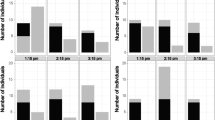Abstract
Taste preference tests, with simultaneous presentation of treated and untreated food, were administered to 24 common vampire bats (Desmodus rotundus). The bats received brief exposures to four different stimuli representing sweet, salty, sour, and bitter tastes, each at four different concentrations. Despite a strong location bias, the bats significantly (P < 0.01) avoided the highest concentrations of the salty, sour, and bitter tastes. Consumption of the sweet stimulus at all concentrations was similar to that of the untreated standard. Vampires evidently can discriminate based on taste, although their ability is apparently poorly developed when compared with some euryphagous species such as the rat. Hence, taste is probably not a factor in host selection by the vampire.
Similar content being viewed by others
References
Bullard, R.W. andThompson, R.D. 1977. Efficacy and safety of the systemic method of vampire bat control.Interciencia 2(3): 149–152.
Christensen, K.R. 1962. Isohedoniccountours in the sucrose-sodium chloridearea of gustatory stimulation.J. Comp. Physiol. Psychol. 55:337–341.
Fishman, I.Y. 1971. Taste responses in the red fox.Physiol. Zool. 44(3):171–176.
Goodwin, G.C., andGreenhall, A.M. 1961. A review of the bats of Trinidad and Tobago.Bull. Am. Nat. Hist. 122:187–301.
Kare, M.R., andFicken, M.S. 1963. Comparative studies on sense of taste, pp. 285–297,in Y. Zotterman (ed.) Proceedings of the First International Symposium on Olfaction and Taste. Pergamon Press, London.
Mann, G. 1960. Neurobiologia deDesmodus rotundus.Invest. Zool. Chil. 6:79–99.
Park, H., andHall, E.R. 1951. The gross anatomy of the tongues and stomachs of eight New World bats.Trans. Kans. Acad. Sci. 54(1):64–72.
Pru, E.L.P., andBriceno, R.V.M. 1972. An unusual relationship between glial cells and neuoronal dendrites in olfactory bulbs ofDesmodus rotundus.Brain Res. 6:404–408.
Schmidt, U., andGreenhall, A.M. 1971. Untersuchungen zur geruchlichen Orientierung der Vampirfledermause (Desmodus rotundus).Z. Vergl. Physiol. 74:217–226.
Shumake, S.A., Thompson, R.D., andCaudill, C.J. 1971. Taste preference behavior of laboratory versus wild Norway rats.J. Comp. Physiol. Psychol. 77(3):489–494.
Shumake, S.A., Thompson, R.D., andCaudill, C.J. 1977. A technique for visual threshold measurement in vampire bats.Physiol Behav. 18(2):325–327.
Suthers, R.A. 1966. Optomotor responses by echolocating bats. Science 152:1102–1104.
Suthers, R.A. 1970. Vision, olfaction, taste, pp. 265–310,in W. A. Wimsatt(ed.). Biology of Bats, Vol. 2. Academic Press, New York.
Thompson, R.D., andGrant, C.V. 1971. Automated preference testing apparatus for rating palatability of foods.J. Exp. Anal. Behav. 15:215–220.
Thompson, R.D., Clay Mitchell, G., andBurns, R.J. 1972. Vampire bat control by systemic treatment of livestock with an anticoagulant.Science 177:806–808.
Turner, D.C. 1975. The Vampire Bat. Johns Hopkins University Press, Baltimore, pp. 61–90.
Young, P.T. 1945. Studies of food preference, appetite, and dietary habit. V. Techniques for testing feed preference and significance of results obtained with different methods.Comp. Psychol. Monogr. 19:1–58.
Young, P.T. 1966. Hedonic organization and regulation of behavior.Psycho!. Rev. 72:59–86.
Young, P.T. 1967. Palatability: The hedonic response to foodstuffs, pp. 353–366,in C.F. Code (ed.) Handbook of Physiology—Alimentary Canal, Vol. 1. Williams and Wilkins, Baltimore.
Young, P.T., andGreene, J.T. 1953. Relative acceptability of saccharin solutions as revealed by different methods.J. Comp. Physiol. Psychol 46:295–298.
Young, P.T., andKappauf, W.E. Apparatus and procedures for studying taste preference in the white rat.Am. J. Psychol. 75:482–484 (1962).
Young, P.T., andMadsen, C.H. 1963. Individual isohedons in sucrose-sodium chloride and sodium saccharin gustatory areas.J. Comp. Physiol. Psychol. 56:903–909.
Author information
Authors and Affiliations
Additional information
This research was conducted, in part, with funds provided to the U.S. Fish and Wildlife Service by the U.S. Agency for International Development under PASA RA (ID) 1–67.
Rights and permissions
About this article
Cite this article
Thompson, R.D., Elias, D.J., Shumake, S.A. et al. Taste preferences of the common vampire bat (Desmodus rotundus). J Chem Ecol 8, 715–721 (1982). https://doi.org/10.1007/BF00988313
Received:
Revised:
Issue Date:
DOI: https://doi.org/10.1007/BF00988313



